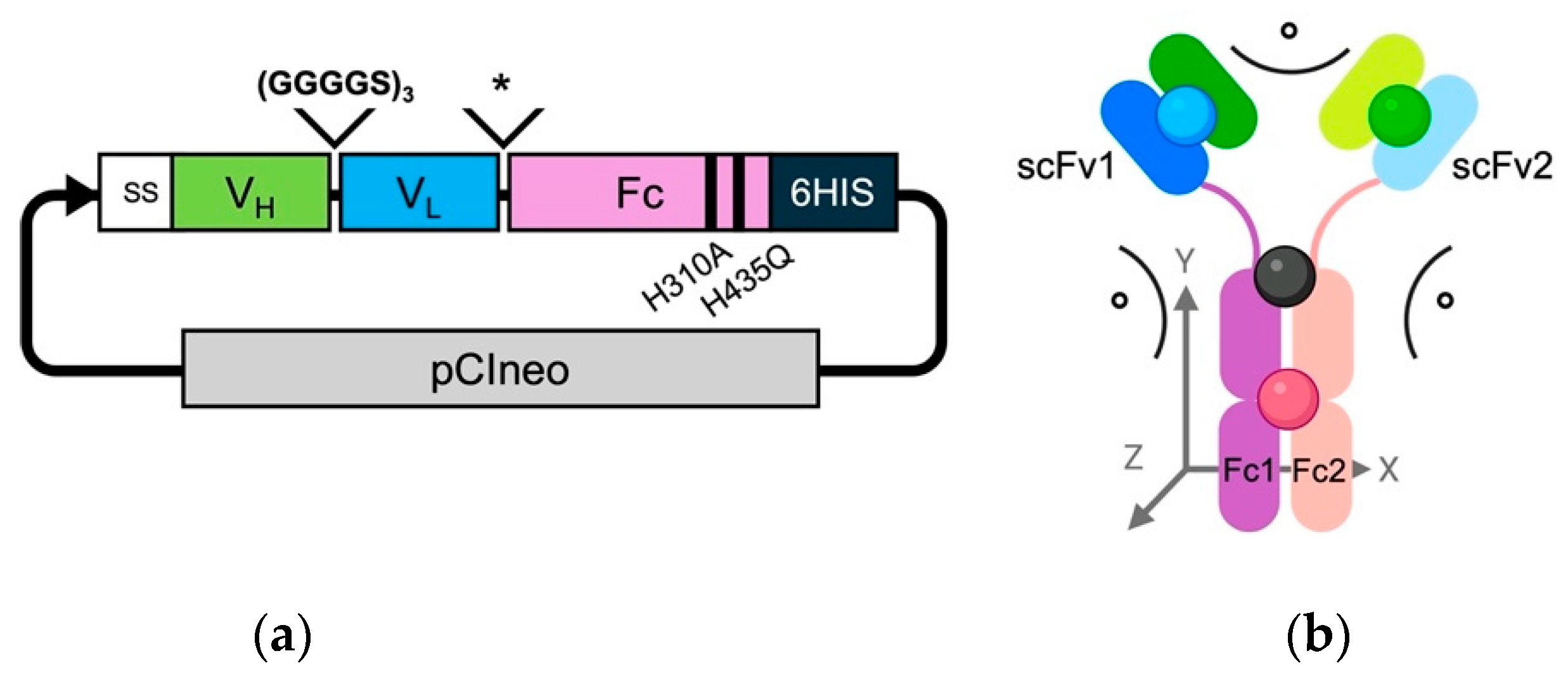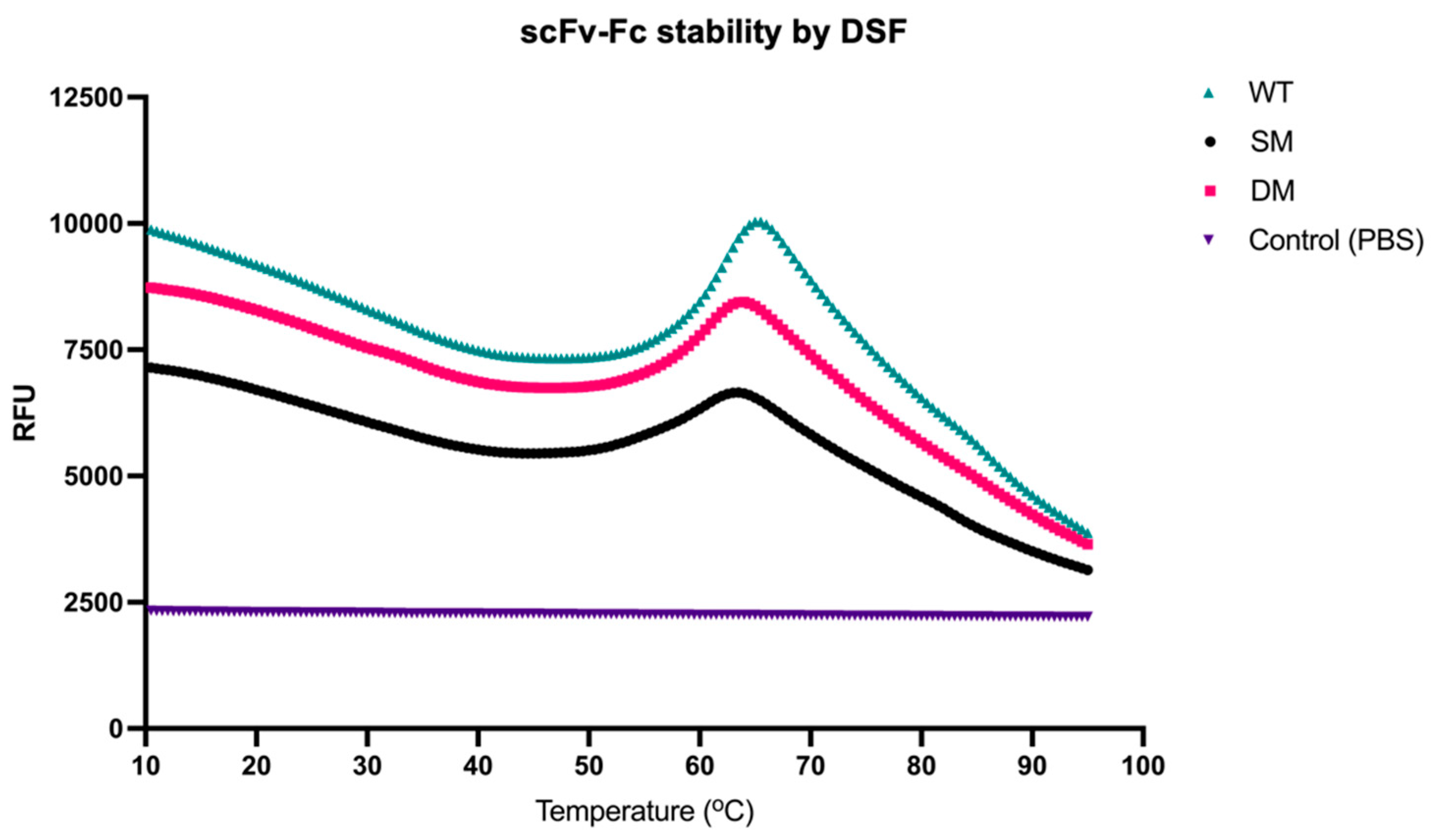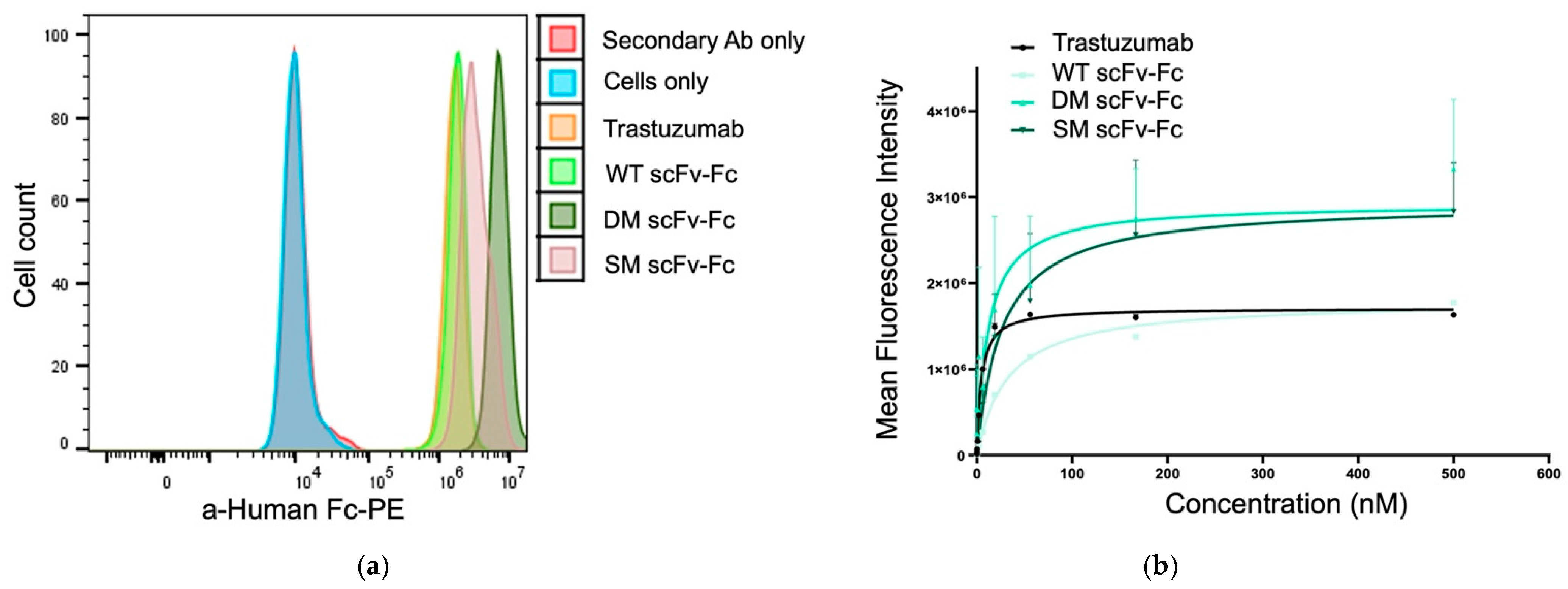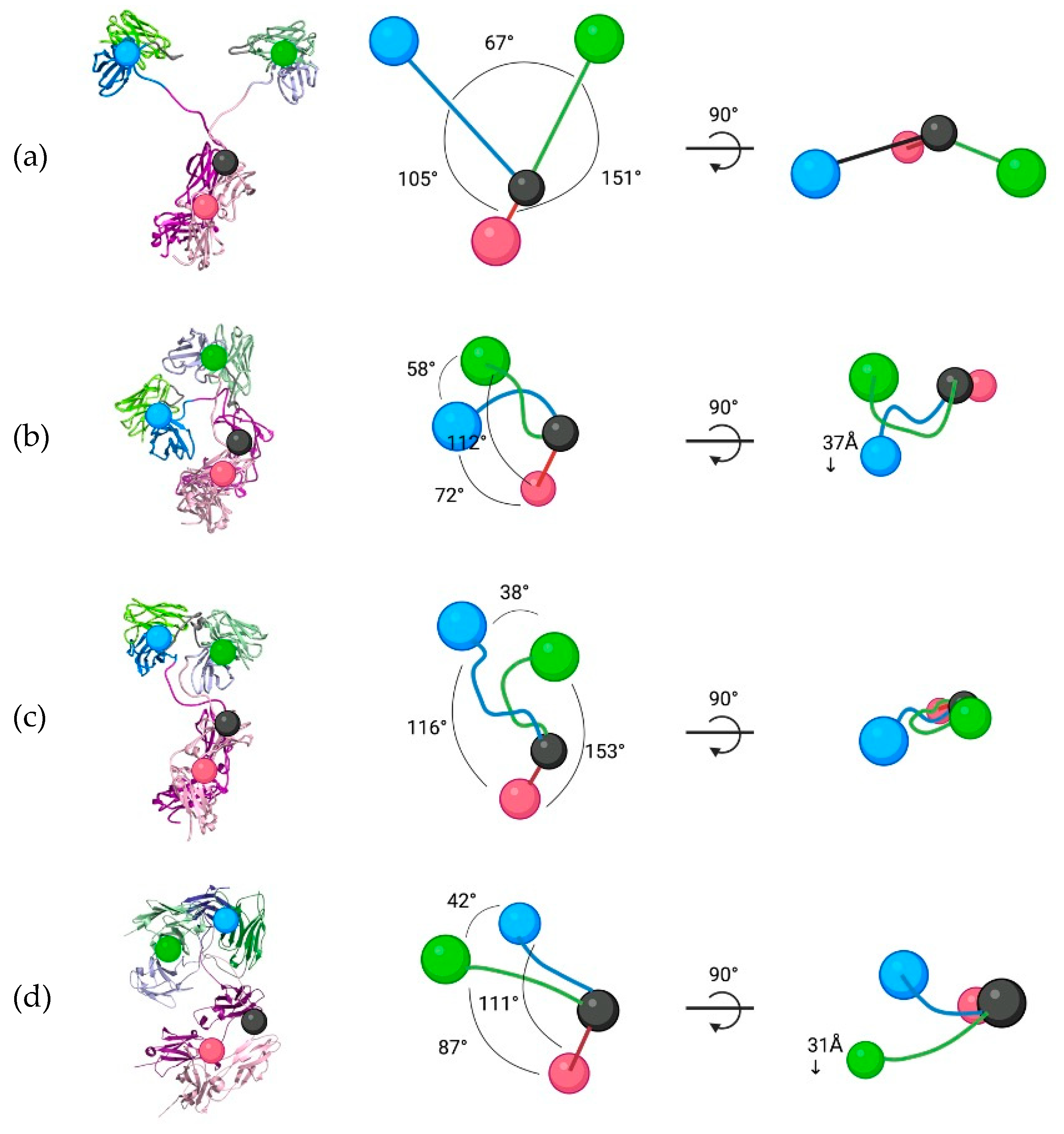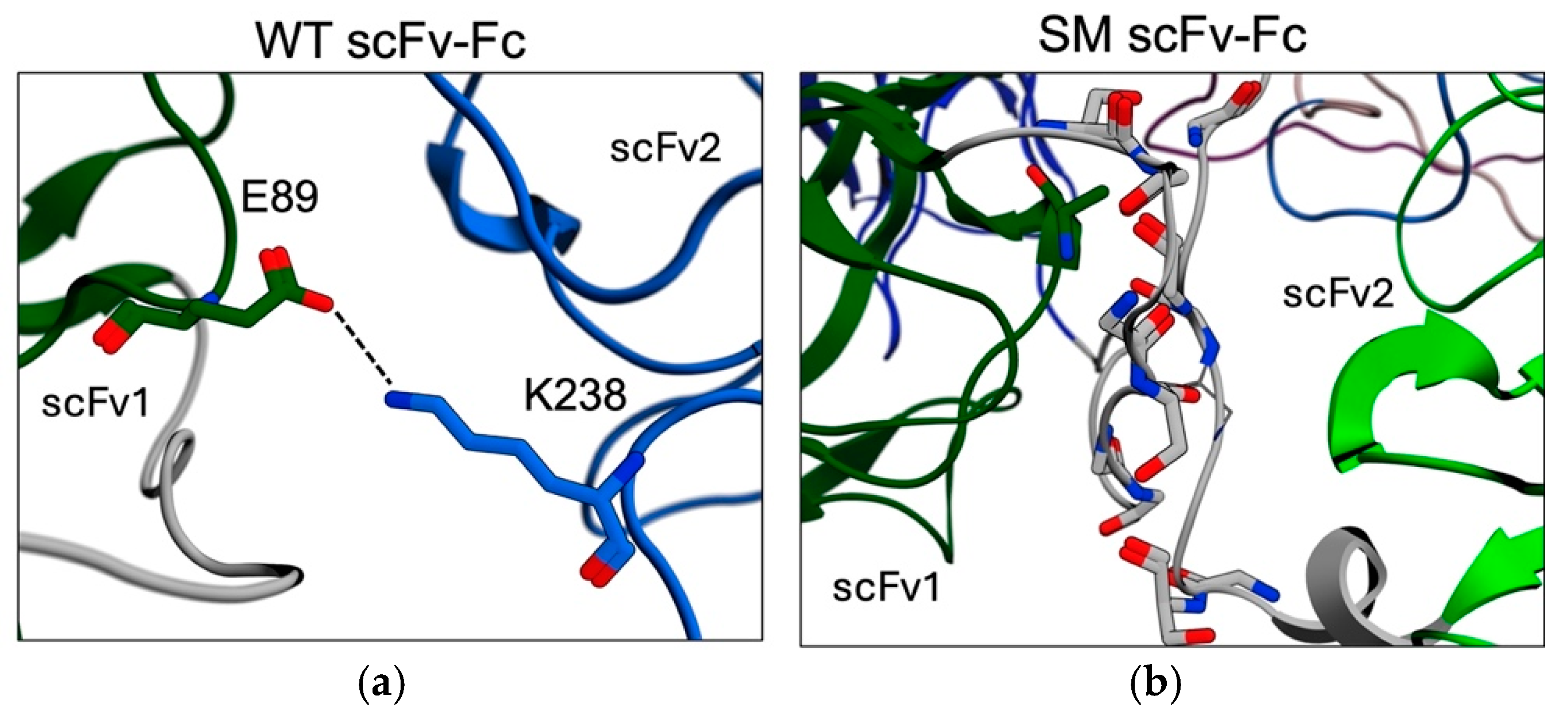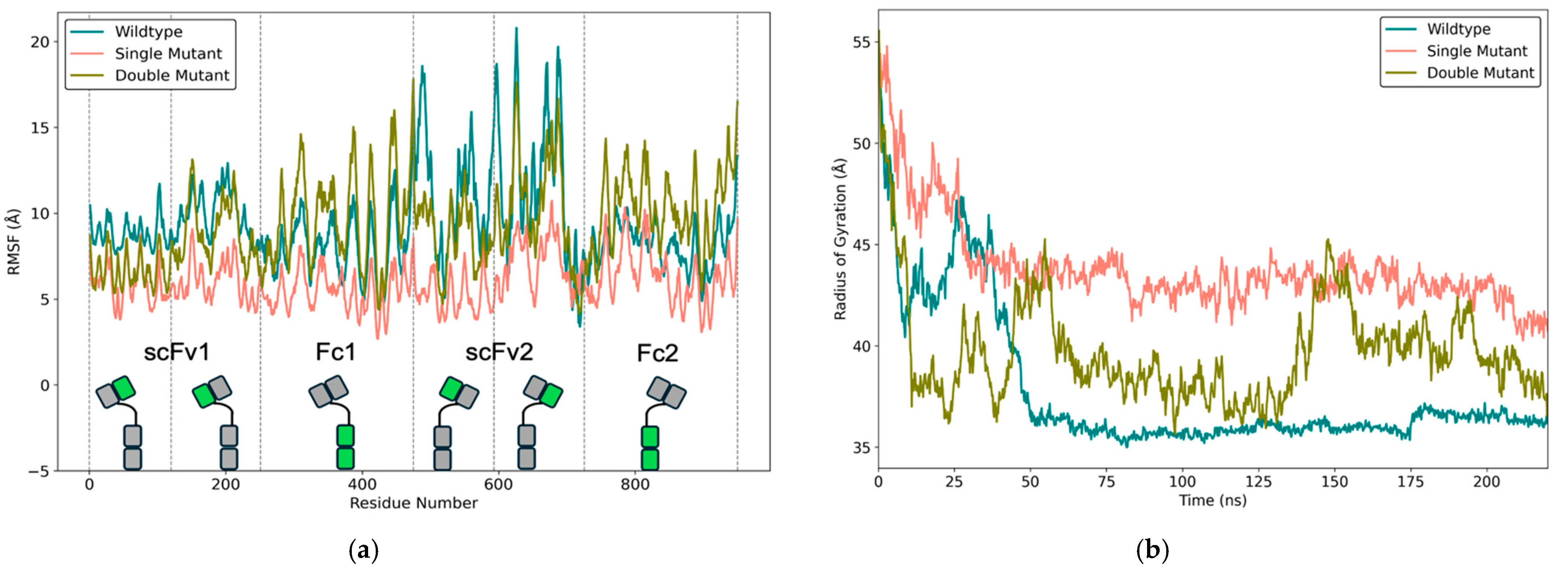1. Introduction
Monoclonal antibodies (mAbs), which represent powerful tools to target antigens, gained prominence over the past 30 years as a preferred treatment option for diverse diseases, including cancer. The Antibody Society reports that approximately 135 antibody-based pharmaceuticals have been approved by the United States Food and Drug Administration [
1]. This success has been due to the significant advancements in antibody engineering, such as humanization, phage-display technologies, and genetic fusions. Such engineering often induces profound changes in a protein’s structure and, therefore, a careful consideration of the three-dimensional (3D) spatial orientations of the entire protein or its individual domains is crucial. This focus on 3D structure is important in optimizing stability and performance, and for propelling the continued demand for engineered antibodies due to their enhanced therapeutic potential.
The single-chain variable fragment (scFv) consists of only the variable light (V
L) and variable heavy (V
H) domains, which are genetically fused by a polypeptide linker. The original pharmaceutical rationale for developing the scFv was to maintain the potent targeting and inhibitory activity of a mAb while producing high yields at a much lower cost compared to mAbs [
2]. Despite the advantages of scFvs, they have a few drawbacks that limit their therapeutic potential. First, scFvs tend to aggregate both in vivo and in vitro and are sensitive to temperature [
3,
4,
5]. As a single unit, the scFv has previously exhibited reduced stability as the V
L and V
H domains separate and rebind frequently and aggregate under small stresses [
6]. Second, because scFvs are approximately 25 kDa, they have an extremely short serum half-life of <1 day compared to days and weeks for immunoglobulin G (IgG) 1 isotype-derived mAbs [
7]. Third, scFvs have reduced affinity compared to the parental mAb counterparts [
8]. Taken together, these drawbacks are the principal causes for the limited number of scFv-approved therapeutics, particularly those that must be administered intravenously [
2].
One difficulty for scFv antigen binding stems from the intrinsic structural orientation of the antigen recognition domains of a mAb. Although the sequence diversity in antibodies is crucial for antigen specificity, the overall folds of the V
L and V
H domains are well conserved. The differences in structure within each variable domain are largely influenced by the complementarity-determining regions (CDRs), which are the six hypervariable loops presented on the ‘tips’ of the structurally conserved frameworks that are essential for antigen binding. Additionally, since an antibody paratope is located at the interface of the V
L and V
H domains, the relative spatial orientations of the CDRs can be influenced by the association of the V
L/V
H heterodimer and can significantly impact the antigen binding properties [
9].
Most currently approved antibodies are those of the IgG
1 isotype [
10]. The structure of an IgG
1 comprises two antigen-binding Fab arms linked to a single fragment crystallizable (Fc) domain via a hinge region. This structural design enables antibodies to bind target antigens bivalently while simultaneously linking with humoral and cellular components of the immune system. The cellular immune responses occur mostly due to the interactions between the Fc and Fc-specific receptors on the surface of immune cells, activating signalling and leading to effector functions such as antibody-dependent cellular cytotoxicity and complement-dependent cytotoxicity [
10]. Notably, the Fc is well known to significantly contribute to the overall stability of an IgG [
11]. The structure of the Fc reveals how the two constant domains, C
H2 and C
H3, of each heavy chain interact with one another. The C
H3 domains pack tightly with each other, while the C
H2 domains have no observable protein–protein contact with each other.
The success of mAb-based therapies is also significantly based on their long circulating half-life, which is dependent on the Fc. The Fc controls the serum and tissue half-life through interactions with the neonatal Fc receptor (FcRn) [
12,
13], and it was originally named based on historical experiments that determined that the FcRn has a major role in mediating the transfer of humoral immunity from mother to neonates [
14]. During IgG circulation in the bloodstream, they are randomly internalized in cells by pinocytosis and contained in the intracellular environment in endosomes, where FcRn is primarily expressed [
10]. IgG
1 antibodies contain conserved histidine residues at the C
H2-C
H3 domain interface that are neutral at a physiologic pH of 7.4. But when exposed to the acidic endosomal environment (pH < 6.5), the histidine residues become protonated and enable the Fc to bind to FcRn [
15]. The IgG-FcRn interaction triggers endosome transport to the cell surface and upon fusion with the plasma membrane and exposure to the extracellular neutral pH environment, the antibody is released. Our current understanding is that this antibody capture and release mechanism by FcRn protects IgGs from lysosomal catabolism and results in their long circulating half-life of 7–21 days depending on the IgG subtype [
16].
For many researchers, the challenge in antibody-based therapeutics lies in antibody conjugate design for delivering cytotoxic payloads. Although unmodified mAbs show some therapeutic potency, their effects tend to be various and ultimately not curative [
17]. For mAbs conjugated to cytotoxic payloads, the long circulating half-life of antibodies is advantageous due to the direct association with target tissue uptake and therapeutic efficacy. There is also a direct causal relationship with increased systemic toxicity. Despite the remarkable advancement of these types of agents such as antibody–drug conjugates (ADCs) with increasing approvals for diverse cancers, there are still serious issues concerning toxicity, which are directly related to prolonged IgG circulation half-life [
18,
19].
The Wu group pioneered the development of several engineered antibody formats based on the scFv unit fused to various components of the hinge and Fc of IgG
1. Specifically, they demonstrated that formats above the threshold for first-pass renal clearance show intermediate clearance rates and reach moderate tumour uptake levels for therapeutic applications with radioactive- or photothermal-emitting payloads [
20,
21,
22]. One format known as the scFv-Fc (110–120 kDa) has been shown to have good properties such as high tumour uptake, comparable to mAbs, but it has slightly faster blood clearance due to its smaller size [
23]. Additionally, Kenanova et al. demonstrated that mutating the conserved histidine residues H310 and H435 at the FcRn binding site of the Fc to alanine (H310A) and glutamine (H435Q) resulted in accelerated blood clearance [
23]. Importantly, the tumour uptake of the mutant scFv-Fc maintained high tumour uptake relative to the parental intact IgG. Additionally, by comparing scFv-Fc with either the wild-type (WT) Fc, H435Q alone (herein termed single mutant (SM)), or H435Q/H310A (herein termed double mutant (DM)), the tumour uptake–blood clearance relationship could be tailored. Ultimately, this provides an opportunity to obtain the rare and desired combination of high tumour-to-background ratios and high absolute tumour uptake required for antibody conjugate therapeutics but at significantly earlier times after administration, thereby potentially minimizing unwanted toxicities and boosting efficacy.
Therefore, the Fc has been the focus of significant engineering to modulate effector function activities. It is well accepted that the mosaic nature of engineered antibody formats exhibits impaired stability when compared to the intact parental antibody, which is owing but not limited to V
H-V
L pairing and potential clashes between different IgG domains that would typically not interact in the full-sized format [
11]. These are serious issues as they can impair high-affinity antigen binding and thermostability, which are essential for success in the clinic. However, the scFv and Fc relationship in the context of the constructed scFv-Fc format is currently unknown.
This work evaluated the impact of engineering on the shape and stability of trastuzumab scFv-Fc and its associations with expression, purification, and binding against human epidermal growth factor 2 (HER2). Specifically, the WT, SM, and DM scFv-Fc antibodies were generated, and their stability was measured using biochemical and computational methods and linked to their expression yields and final purities. Their performance was measured by flow cytometric analyses for binding HER2-positive JIMT-1 cells. Our findings revealed that these scFv-Fc antibodies have stochastic and markedly different spatial structural orientations that impact their overall stabilities and binding activities, and that did not involve the amino acid mutations. Importantly, the scFv subunits drove instability through direct interchain interactions, causing large-scale scFv-Fc structural deformations. If abundant expression and stable fractions were obtained, the DM scFv-Fc antibody retained the least structural reorganization and was biochemically associated with excellent dimerization and nanomolar affinity for HER2 when compared to trastuzumab.
2. Materials and Methods
2.1. Cell Lines
The human breast cancer cell line JIMT-1 (CVCL-2077) with HER2 overexpression was cultured in monolayers by serial passages in high glucose Dulbecco’s Modified Eagle’s medium (DMEM) (Hyclone Laboratories, Logan, UT, USA). The media was supplemented with 10% fetal bovine serum (FBS) (Biochrom, Sigma-Aldrich, St Louis, MO, USA) and 1% penicillin–streptomycin (Hyclone Laboratories). This cell line was authenticated using short tandem repeat profiling at the Centre for Applied Genomics (Hospital for Sick Kids, Toronto, ON, Canada). The human breast cancer SK-BR-3 cell line (Cedarlane, Burlington, ON, Canada) was cultured in McCoy’s 5a Medium (Wisent, St-Bruno, QC, Canada) supplemented with 10% FBS and 2 mM L-glutamine (Wisent, Saint-Jean-Baptiste, QC, Canada). Human embryonic kidney HEK293T (CRL-3216) and Chinese hamster ovary CHOK1 (CCL-61) cell lines (Cedarlane) were cultured in DMEM/F12 medium (Wisent) supplemented with 10% FBS (Wisent). ExpiCHO-S cells were cultivated in serum-free ExpiCHO Expression Medium (ThermoFisher, Waltham, MA, USA), following the manufacturer’s recommendations. All cells were free of mycoplasma prior to use.
2.2. scFv-Fc Genetic Engineering Design
Trastuzumab variable heavy (V
H) and light (V
L) chains were amplified from pVITRO1-Trastuzumab-IgG1/κ (Plasmid #61883; Addgene, Watertown, NY, USA) plasmid and linked using a (GGGGS)
3 linker. The human IgG
1 Fc coding sequence (GenBank: KY053479.1) was synthesized by Integrated DNA Technologies (Coralville, IA, USA) and fused downstream of the VEPKSC linker and a mutated (
underlined) human IgG
1 hinge DKT
YTCPPCP (
Figure 1a). The H/Y substitution in the hinge was used as this was previously shown to protect from degradation during mammalian expression [
24]. The V
H-V
L-Fc coding wild-type Fc expression cassette was fused under the control of an interleukin-2 secretion signal sequence. A 6x-histidine sequence was fused at the C-terminus. Desired mutations in the Fc region were further introduced using overlapping polymerase chain reaction (PCR) and with the following primers: 5′-GAGGCTCTGCACAACCAGTACACGCAGAAG-3′ for H435Q and 5′-GTCCTCACCGTCCTGGCCCAGGACTGGCTGAATG-3′ for H310A mutations, respectively.
All cDNA fragments were fused by overlapping PCR using the NEBuilder HiFi DNA Assembly Cloning Kit (New England Biolabs, Ipswich, MA, USA) and cloned into pCIneo plasmid backbone (Catalog # E1841, Promega, Madison, WI, USA) for further expression in mammalian cell lines. Escherichia coli DH5α cells were transformed with the plasmids encoding the different antibodies. Transformed cells were plated on LB agar plates containing 100 µg/mL carbenicillin and incubated overnight at 37 °C. Recombinant plasmids containing the scFv-Fc genetic constructs were purified using the E.Z.N.A.® Endo-free Plasmid DNA Mini Kit I (Omega Bio-tek, Norcross, GA, USA) and sequenced for correct gene fusion sequence identification.
2.3. Expression and Purification of scFv-Fc Antibodies
Adherent cellular expression was performed using CHOK1 and HEK293T cells. Prior to transfection, the cells were seeded in 100 mm plates (5 × 106 cells for CHOK1 and 7.5 × 106 cells for HEK293T) overnight. When cells reached ~75% confluency, the media was replaced with the same media absent of FBS. A transfection mixture was prepared according to the Lipofectamine 3000 transfection reagent instruction. Notably, Lipofectamine 3000 was mixed with Opti-Mem serum-reduced media (ThermoFisher) containing 14.75 µg of plasmid DNA. Twenty-four hours after transfection, cell media was replaced with normal culture media and expression was allowed to continue for three, five, and seven days, at which time the cells were centrifugated at 4000× g for 10 min at 4 °C, and then the supernatant was collected and passed through a 0.22 µm filter.
Suspension cellular expression was performed by using the ExpiCHO™ expression system (ThermoFisher) following the manufacturer’s recommendations. Twenty-four hours before transfection, ExpiCHO-S cells were diluted to a final density of 3 × 106 cells/mL. The following day, the cells were counted and transferred into a fresh 125 mL Erlenmeyer flask containing 25 mL of prewarmed ExpiCHO expression medium to reach a final density of 6 × 106 cells/mL. Then, 25 ug (1 µg per 1 mL of medium) of plasmid was added to 1 mL of cold OptiPRO medium. Separately, 80 µL of ExpiFectamine was diluted in 920 µL of OptiPRO medium. The two solutions were then combined and incubated at room temperature for 5 min, and then slowly transferred to the flask containing the ExpiCHO-S cells. The cells were incubated at 37 °C in a humidified atmosphere of 8% CO2 on an orbital shaker set to 125 revolutions/min. The next day, 150 µL of ExpiFectamine CHO Enhancer and 6 mL of ExpiCHO Feed were added to the expression flask. After eight days, supernatants were harvested as previously mentioned.
Antibodies were purified using HisPur Cobalt Superflow Agarose (ThermoFisher). Collected media was diluted 4 times using equilibration buffer (20 mM sodium phosphate, 300 mM sodium chloride, and 5 mM imidazole; pH 7.4) and incubated with cobalt beads at 4 °C on a rotator overnight. The next day, the samples were centrifuged at 700× g for 2 min. The supernatants were carefully removed and discarded. The resin was washed in two resin-bed volumes of wash buffer (20 mM sodium phosphate, 300 mM sodium chloride, and 10 mM imidazole; pH 7.4). Then, the samples were centrifuged for two min at 700× g and the supernatants were carefully removed. Next, three washing steps were performed and the antibody fragments were eluted by suspending the resin bed for 10 min in one resin-bed volume of elution buffer (20 mM sodium phosphate, 300 mM sodium chloride, and 150 mM imidazole; pH 7.4). The samples were centrifuged for 2 min at 700× g and the supernatants were collected and concentrated using 10 kDa cut-off Amicon Ultra-0.5 mL Centrifugal Filters (MilliporeSigma, St Louis, MO, USA).
The scFv-Fc genetic constructs were also subcloned into proprietary expression vectors by ABclonal (Woburn, MA, USA), which then transfected Expi293F cells (Thermo Fisher) using PEI MAX (Polysciences, Warrington, PA, USA). The supernatant was separated after incubation in Expi293 expression medium at 37 °C for five days, and proteins were purified with Ni-Agarose (Cube Biotech, Monheim am Rhein, Germany).
2.4. Purity Determination
SDS-PAGE was initially performed to evaluate antibody purities based on molecular weight (m.w.). The samples were denatured at 98 °C for three min and 10 µg of total protein was loaded onto 7.5% Mini-PROTEAN TGX Precast Protein Gel (Bio-Rad, Hercules, CA, USA). The samples were electrophoresed under reducing (dithiothreitol (DTT)) and non-reducing conditions and stained using Coomassie blue.
Antibody purities and integrities were also determined using size-exclusion high-performance liquid chromatography (SEC-HPLC) (Waters 2796 Bioseparations Module, Waters 2487 Dual λ Absorbance Detector, Xbridge® BEH 200 A SEC 3.5 µm 7.8 × 150 nm column; Waters Corporation, Milford, MA, USA). The UV detector was set at 220 nm and 280 nm. The mobile phase flow rate was 0.25 mL/min for 40 min. Elution times of the scFv-Fcs were compared to the parental trastuzumab. An Agilent 2100 Bio-analyzer system (Agilent High Sensitivity Protein 250 Kit- Catalog # 5067-1575, Santa Clara, CA, USA) was utilized to further confirm purities and m.w. values, following the manufacturer’s protocol.
2.5. Differential Scanning Fluorimetry
The thermal stability of the scFv-Fc antibodies was evaluated by differential scanning fluorimetry (DSF) and performed using the CFX96 Real-Time PCR System (BioRad, Hercules, CA, USA). For each measurement, 1 mg/mL concentrations of each scFv-Fc were suspended in 25 µL PBS, pH 7.0, containing 2.5 µL of 50× SYPRO Orange Protein Gel stain. The tubes were heated from 10 °C to 95 °C at five °C intervals for 65 min and the resulting fluorescence data were collected. The data were then transferred to GraphPad Prism Version 9 (GraphPad, San Diego, CA, USA) for analysis by plotting the negative derivative of relative fluorescence versus temperature. The temperature of the maximal fluorescent value of the first derivative of the unfolding event is the Tm and each condition was prepared in triplicate.
2.6. Binding Kinetics by Flow Cytometry
JIMT-1 cells were incubated with the antibodies at increasing concentrations (12 points following threefold serial dilutions) in triplicates in 100 µL of PBS for 30 min at 4 °C. The cells were then twice washed in PBS and then suspended in a 1:100 dilution of fluorescently labelled secondary antibody goat anti-human IgG Fc (Catalog # 12-4998-82, ThermoFisher). The cells were then washed as previously described, suspended in 200 µL of PBS, and analyzed using a CytoFLEX flow cytometer (Beckman Coulter, Indianapolis, IN, USA). The flow cytometric data were analyzed using FlowJo (version 10.7.2; FlowJo LLC, Ashland, OR, USA). GraphPad was used to determine the binding dissociation constant (KD), maximum binding capacity (Bmax), and the half-maximal effective concentration (EC50) values.
2.7. In Silico scFv-Fc Building
The scFv-Fc antibodies were built by first loading the amino acid sequence of the scFv alone into a Molecular Operating Environment (MOE; Chemical Computing Group, Montreal, QC, Canada) and utilizing the antibody modeller feature set for ‘scFv’ that contains several trastuzumab Fab structures. A human IgG
1 crystal structure (PDB: 1HZH [
25]) was imported into MOE to represent the human IgG
1 Fc segment as the amino acid sequence was identical to the Fc of the scFv-Fc WT. The modelled trastuzumab scFvs were then attached to the Fc via the amino acids, VEPKSC, which were manually inserted to connect with the N-terminal portion of the human IgG
1 hinge–Fc. The H435Q and H435Q/H310A substitutions were made for the SM and DM scFv-Fc antibodies, respectively. The final in silico-generated scFv-Fc antibodies were inspected for correct amino acid sequences and protonation states at pH 7.4, and then the proteins underwent energy minimization.
2.8. Molecular Dynamic (MD) Simulations, RMSD, RMSF, Rg, and Structural Angle Changes
MD simulations were performed on the scFv-Fc antibodies using the Desmond MD package (version 13.7.125) [
26]. The systems were minimized using the PrepWizard utility [
27] and set up for explicit solvent simulations. The virtual antibodies were individually placed in an orthorhombic box containing TIP3P water and 1.15 M NaCl and the box dimensions were reduced to 76 nm × 43 nm × 86 nm, leaving 1.5 nm separation from the scFv-Fc and the box edges on all sides, and visually confirmed using Visual Molecular Dynamics [
28]. The simulations were performed for 220 nanoseconds (ns) at 310 K, 1 atm. For each scFv-Fc, all frames were aligned to their initial energy-minimized structure on the ɑ-carbon atoms.
The Python MD Analysis library (version 2.9.0) [
29] was used to analyze the MD trajectories for each engineered antibody using the minimized starting structure and the clustered MD configuration from the simulation. These structures were used to determine root mean square deviation (RMSD), root mean square fluctuation (RMSF), and radius of gyration (Rg) changes over time. Clustered conformations were calculated using Desmond Trajectory Clustering, setting the maximum clusters to 1 [
26]. MD movies were rendered using VMD [
28]. The equilibrated 220 ns trajectories were loaded and the timestep (dt) was set to 10 over the 1003 frames.
To contextualize the spatial reorganization of the scFv-Fc antibodies during MD simulations, structural angular changes were analyzed relative to their starting energy-minimized conformations. The WT, SM, and DM scFv-Fc MD-clustered structures were compared to their respective initial counterparts to quantify conformational shifts. A central pivot point and reference center points were established as outlined in
Figure 1b, providing a method for interpreting structural changes. This approach was essential for three key reasons. First, the alignment of the Fc regions between the starting and MD-clustered conformations revealed a deviation of ≤2 Å, confirming that the Fc domain remained relatively stable throughout the simulation. Second, using defined center points enabled a more consistent and reliable method for quantifying angular changes, treating each scFv as a discrete structural unit. Third, given the pronounced spatial reorganization observed in the scFv and hinge regions, the N-terminal residues (P238) of both Fc chains were designated as the central pivot point to provide a standardized reference for measuring structural displacement. In addition, conformational changes in the z-axis (Å) of each scFv were measured relative to the pivot point, capturing the extent of spatial reorganization over the course of the MD simulations. This approach provided a comprehensive structural analysis, elucidating the dynamic fluctuations that may influence antigen binding and overall scFv-Fc stability.
For evaluating changes in spatial organizations of the CDRs, the scFv1 and scFv2 subunits of the MD-clustered scFv-Fc configurations were aligned onto the crystal structure of an unbound trastuzumab Fab fragment (PDB file 6BHZ [
30]). The C
L and C
H1 domains were deleted prior to alignment. The scFv1 and scFv2 energy-minimized structures were aligned onto the trastuzumab V
L/V
H domains prior to MD simulations to ensure alignments of RMSD < 1 Å. The scFv-clustered MD conformations were then aligned to their original energy-minimized counterpart structures and the RMSD changes were determined.
4. Discussion
This study investigated the biochemical and structural behaviours of trastuzumab-derived engineered scFv-Fc constructs and aimed to determine the significance of HER2 binding performance and to infer their future potential as therapeutic agents. First, it was found that the VH-VL orientation was less prone to aggregation compared to the VL-VH orientation. Second, high expression levels were challenging to achieve but scalable production was feasible. Third, the fragments were observed to be highly sensitive to purification and dimer purities varied. Fourth, thermal stability experiments revealed that all fragments exhibited similar melting points, albeit lower than trastuzumab. Fifth, flow cytometric assays on JIMT-1 cells demonstrated that the DM scFv-Fc antibody displayed the overall best affinity for HER2, albeit clearly weaker than trastuzumab. Sixth, MD simulations revealed that the WT and SM scFv-Fc antibodies underwent severe stochastic reorganizations compared to the DM scFv-Fc antibody. Seventh, mutations in the Fc domain showed no influence on structural configuration and stability. Finally, contact energy comparisons between energy-minimized and clustered MD scFv structures indicated that inter-antibody chain interactions drove large-scale reorientations, favouring scFv-Fc compactization. Taken together, the Fc does not appear to provide improved stability to an engineered antibody of a traditional scFv-Fc format, as was typically thought in the field. Additionally, although intra-domain unfolding was marginal and the scFv binding site CDRs remained stable, the scFv-Fc format is subject to significant large-scale structural reorganization, causing reoriented rigid conformations of the scFv subunits that limit bivalent binding.
Antibody engineering approaches have evolved tremendously during the past decades. The methods of computational protein design for engineering highly stable scFvs have been approached in earnest [
39,
40]. While computer modelling helps guide design and allows for identifying and analyzing potential weak points, experimental testing remains necessary to establish the clinical potential of engineered antibodies. The scFv format is popular due to its simple engineering design concept and its ability for fast accumulation and deep penetration into target tumours. However, its small size results in extremely short half-lives in plasma, which is a drawback if absolute high tumour uptake is required to evoke effective anti-tumour responses [
41]. More importantly, for therapeutic design, we must consider that scFvs decrease thermal stability and potential to aggregate [
42] in the context of larger-sized formats, which is an area that has not received sufficient attention.
It is currently accepted that the genetic fusion to Fc domains of IgG
1 antibodies offers a reliable strategy to improve the overall stability of scFv-based therapeutics by capitalizing on dimerization due to interchain interactions between residues in the opposing hinge and C
H3 domains. Despite their increased size, which counters the rapid tumour accumulation rate of scFvs, these fusion fragments still maintain faster tissue penetration and blood clearance compared to classical larger mAbs. Additionally, their half-life can be finely tuned through strategic point mutations within the Fc domain, particularly at amino acids I253, H310, H433, and H435 [
43]. These residues serve as critical binding sites located at the interface of the C
H2 and C
H3 domains, where interaction with the FcRn receptor occurs. Introducing mutations at these key positions enables precise modulation of the disruption level in the interaction between the Fc domain and FcRn, leading to a diverse array of pharmacokinetic and tumour uptake profiles [
44,
45,
46]. Therefore, this approach has been mostly viewed as promising to potentially enable these types of agents to reduce exposure times to healthy tissue while enhancing tumour-targeting specificity and therapeutic efficacy.
It is well known that the high degree of IgG conformational flexibility is vital for effective antigen binding by the CDRs. What is less appreciated but also equally important for effective antigen binding is that the V
H and V
L domains undergo conformational changes independently of each other as they form weak interactions for their dimerization. This independence allows for flexibility in the arrangement of these domains and the CDRs, which is important for antigen recognition and binding by an antibody. ‘Rewiring’ the connectivity of the V
H and V
L domains via an scFv format has been shown to change their dynamics and geometric orientation of the antigen binding site [
33,
47] and affect binding strength [
32,
33,
47]. Engineered antibody fragments employing the V
L-V
H orientation have been shown to have increased flexibility but reduced antigen specificity compared to the parental antibodies [
36]. Because the CDR3 loop of the V
H domain is essential for antigen binding, it was previously reported that in a V
H-V
L orientation, the flexible linker will not interfere with the CDR3 loops and, hence, limit the possibility of adversely interfering with antigen binding [
48]. In this study, we observed that the linker was the main driver for the upright and rigid conformation for the SM scFv-Fc (
Figure 6b). The two linkers from each scFv subunit formed multiple hydrogen bonds, which caused the binding domains to face approximately 180° in opposite directions (
Figure 5c).
MD simulation provided key insights into how structural conformations influenced the binding performance of the scFv-Fc antibodies. The WT and SM scFv-Fcs exhibited the greatest structural reorganizations and correspondingly had the poorest binding affinities against HER2+ JIMT-1 cells (
Table 2). In the WT scFv-Fc, scFv1 became stabilized between scFv2 and the Fc (
Figure 5b), which most likely restricted its accessibility to HER2. Similarly, in the SM scFv-Fc, both scFv subunits were stabilized in a configuration that also likely reduced bivalent HER2 binding. In contrast, the DM scFv-Fc had both of its scFv subunits elongated, which supported maintaining the bivalent binding of HER2. Nevertheless, the WT scFv-Fc displayed a Bmax similar to trastuzumab, suggesting that despite its compact structure, it could still recognize HER2 with the same number of available binding sites. This raises the possibility that even the contracted and stabilized scFv subunit in the WT scFv-Fc might retain some degree of conformational flexibility, enabling it to extend upon antigen engagement and achieve bivalent binding.
In contrast, the SM scFv-Fc exhibited a higher Bmax, which may indicate that the strong interactions between the scFv linkers lock the two scFvs in a rigid conformation, preventing effective bivalent binding. This rigid structure likely requires a greater number of SM scFv-Fc molecules to saturate all HER2 binding sites. The DM scFv-Fc also displayed a high Bmax, which is more difficult to explain given its relatively stable structure. One possible interpretation is that while the scFvs remain mostly extended, one scFv underwent transient contraction, which could have reduced its availability for HER2 binding at certain time points. Indeed, MD simulations showed that the DM scFv-Fc momentarily contracted before re-extending (
Supplementary Materials, Movie S3). Taken together, these findings emphasize the importance of structural flexibility in scFv-Fc design and highlight the need to balance stability with dynamic adaptability to ensure efficient antigen binding in antibody fragment-based therapeutics.
The DSF results suggest that the introduced mutations in the Fc region, represented by the SM and DM variants, did not substantially alter the thermal stability of the scFv-Fc antibodies compared to the WT scFv-Fc counterpart. The overall weaker stability compared to that previously reported for trastuzumab [
37] indicates the scFv-Fc format itself is less stable. Further investigations into other aspects of stability, such as long-term storage stability or resistance to denaturation under different conditions, would provide a more comprehensive understanding of the impact of these mutations on the overall stability of the scFv-Fc antibodies. Nonetheless, 5-week storage of these agents at 4 °C revealed that the dimer population remained stable (
Figure 2b).
The combined in silico and biochemical studies provided essential insights into scFv-Fc development, revealing this ‘traditional’ engineered antibody fragment format does not fully maintain the classical Y-shape. Instead, MD simulations demonstrated that scFv subunits undergo stochastic movement, leading to significant fluctuations in their spatial positions. This dynamic behaviour increased interchain interactions that restricted motion and most likely limited HER2 accessibility, supported by the weaker binding affinities. Notably, the spatial positioning of the CDRs remained largely unchanged and further supports that large-scale structural rearrangements and not intra-domain unfolding were the root causes for poor binding performances. While high RMSF values were observed, these did not reflect structural instability. Rather, they signify tolerable flexibilities, which can possibly positively (DM) or negatively (WT and SM) influence HER2 binding. Overall, this study demonstrated that the scFv-Fc format introduces inherent dynamic motions that negatively impact overall binding efficiency, with the linker–hinge segment connecting the scFv to the Fc as the primary source of instability. Although the overall conformations of the scFv-Fc are stochastic, the DM scFv-Fc exhibited the most favourable properties for preclinical therapeutic applications.
Future development efforts will likely require advanced computational protein design strategies, including artificial intelligence, to enhance scFv-Fc stability and mitigate stochastic conformational fluctuations. The use of computational modelling in this study proved essential for precisely identifying structural regions for optimization and aligned well with the experimental biochemical results. Lastly, this work underscores the importance of an interdisciplinary approach to antibody engineering, integrating computational modelling with experimental validation to develop next-generation antibody fragments for therapeutic applications.
